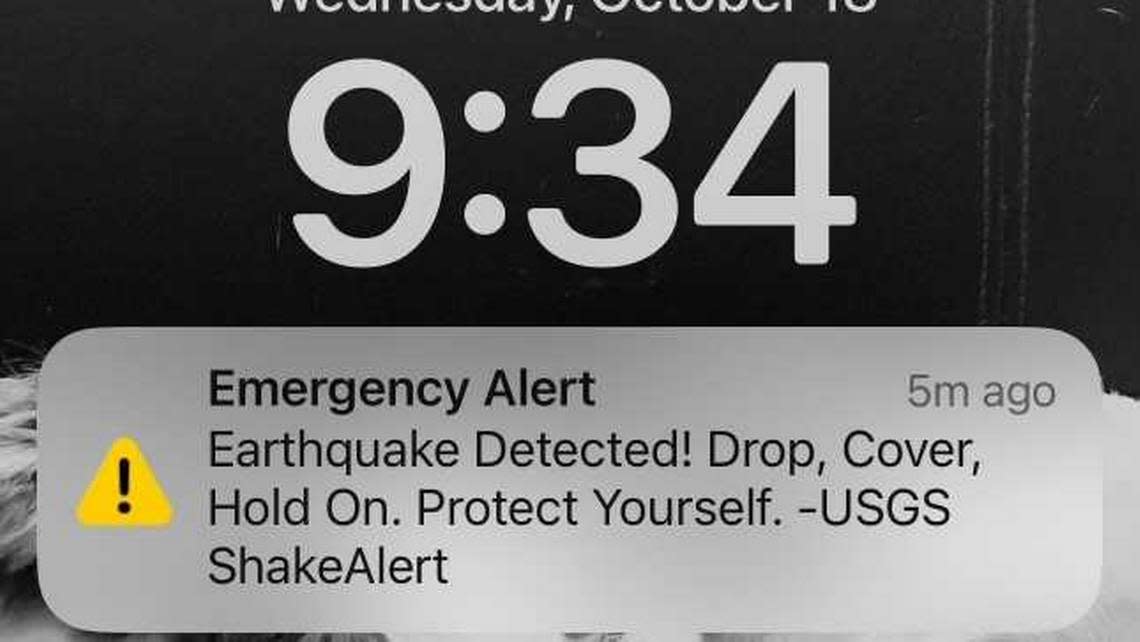Why did I get an earthquake alert this morning? How California’s warning system works
Were you one of the people in Northern California who received an earthquake alert on Wednesday morning as a 4.2-magnitude earthquake hit Brannan Island in Sacramento County?
That’s because you were within close proximity to the epicenter and were at risk of feeling the shake.
Here’s who sends out the alert to your phone and why you were buzzed:
What alerting system does California use for earthquakes?
California uses the ShakeAlert Earthquake Early Warning System to notify those in close proximity to an earthquake a few seconds before it hits.
The system is managed by the U.S. Geological Survey, according to the ShakeAlert website. Once an earthquake is detected it is “turned over to third parties to deliver alerts,” said Robert de Groot, a lead ShakeAlert operations team member.
“We are the data provider, we provide the information and then we hand it over to apps like my MyShake App, who then take that information and make decisions about where alerts should be delivered,” de Groot said.

How early can an earthquake be detected?
The system detects the earthquake when it reaches the surface.
“That’s when the whole system kicks into action,” de Groot said.
“Once that earthquake is detected within a second or so, information is collected and then passed on to a processing center, that information is then processed over a couple of seconds, and then it’s made available.”
From start to finish the whole process takes anywhere from 6 to 8 seconds to get to your phone.
Which parts of Sacramento County have the highest earthquake risk? Here’s what experts say
What makes an earthquake alert go off?
An earthquake magnitude should be measured at a 4.5 size for the ShakeAlert system to go into action. Wednesday’s earthquake was originally clocked at 4.7, but later downgraded to 4.2.
The system will estimate the size of the earthquake with about one second worth of data from the earthquake, de Groot said.
If the system asses the earthquake reaches the 4.5 threshold is sends the appropriate alert.
Who gets warned of an earthquake?
The size of the earthquake helps the system determine who receives an alert.
A rule of thumb for the system when determining who receives an alert are those who could feel shaking that’s equivalent to a truck passing by their house, de Groot said.
Anyone who is within those parameters will receive an alert. That’s why residents in Sacramento County and the Bay Area heard Wednesday’s warning.
“Our goal is to get alerts to prioritize alert delivery to people who could feel the heaviest shaking because those people are in the most danger,” de Groot said.
There’s no set number of miles for this parameter — it’s all about the expected magnitude.
What should you do during an earthquake?
Sacramento County’s Office of Emergency Services website offers several tips on what to do during an earthquake, including:
Drop (or lock): Drop down to your hands and knees and hold onto something sturdy nearby. For those in a wheelchair or walker, make sure the wheels are locked and remain seated.
Cover: Cover your head and neck with your arms. If there is a sturdy object such as a table or desk, crawl underneath it for shelter. When nothing sturdy is nearby, crawl next to an interior wall that avoids windows.
Hold on: For those under a sturdy object, hold onto it with one hand and be ready if it moves.
After an earthquake, the OES advises those affected by the earthquake to:
Be alert to other possible hazards such as downed power lines.
Expect possible aftershocks.
Go outside and move away from buildings.
If you are trapped, try to get someone’s attention through text message or banging on nearby objects.
Earthquake drill in California
On Thursday, Californians will be able to participate in the annual international ShakeOut.
“The annual Great California ShakeOut is a statewide earthquake drill that helps remind folks the steps to take to stay safe during an earthquake, you know, we experienced one here in Sacramento today,” said Brian Ferguson, deputy director of crisis communication at the California Governor’s Office of Emergency Services.
At 10:19 a.m., those who are signed up to receive earthquake alerts will get a text on their cellular phone about the drill, according to the website.
“Earthquakes are actually the most damaging disaster we could face as a state,” Ferguson said.
The drill on Thursday comes a day after the 4.2-magnitude earthquake in Sacramento County and two days after the 34th anniversary of the Loma Prieta earthquake in San Francisco.
What do you want to know about life in Sacramento? Ask our service journalism team your top-of-mind questions in the module below or email servicejournalists@sacbee.com.
